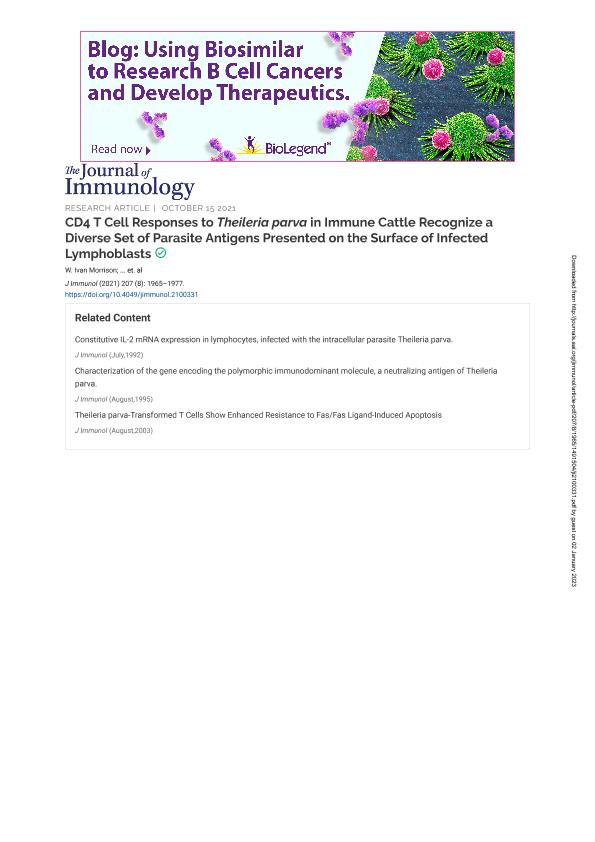Mostrar el registro sencillo del ítem
dc.contributor.author
Morrison, W. Ivan
dc.contributor.author
Aguado, Adriana
dc.contributor.author
Sheldrake, Tara A.
dc.contributor.author
Palmateer, Nicholas C.
dc.contributor.author
Ifeonu, Olukemi O.
dc.contributor.author
Tretina, Kyle
dc.contributor.author
Parsons, Keith
dc.contributor.author
Fenoy, Luis Emilio

dc.contributor.author
Connelley, Timothy
dc.contributor.author
Nielsen, Morten

dc.contributor.author
Silva, Joana C.
dc.date.available
2023-01-02T18:53:15Z
dc.date.issued
2021-09
dc.identifier.citation
Morrison, W. Ivan; Aguado, Adriana; Sheldrake, Tara A.; Palmateer, Nicholas C.; Ifeonu, Olukemi O.; et al.; CD4 T Cell Responses to Theileria parva in Immune Cattle Recognize a Diverse Set of Parasite Antigens Presented on the Surface of Infected Lymphoblasts; American Association of Immunologists; Journal of Immunology; 207; 8; 9-2021; 1965-1977
dc.identifier.issn
0022-1767
dc.identifier.uri
http://hdl.handle.net/11336/182967
dc.description.abstract
Parasite-specific CD8 T cell responses play a key role in mediating immunity against Theileria parva in cattle (Bos taurus), and there is evidence that efficient induction of these responses requires CD4 T cell responses. However, information on the antigenic specificity of the CD4 T cell response is lacking. The current study used a high-throughput system for Ag identification using CD4 T cells from immune animals to screen a library of ~40,000 synthetic peptides representing 499 T. parva gene products. Use of CD4 T cells from 12 immune cattle, representing 12 MHC class II types, identified 26 Ags. Unlike CD8 T cell responses, which are focused on a few dominant Ags, multiple Ags were recognized by CD4 T cell responses of individual animals. The Ags had diverse properties, but included proteins encoded by two multimember gene families: five haloacid dehalogenases and five subtelomere-encoded variable secreted proteins. Most Ags had predicted signal peptides and/or were encoded by abundantly transcribed genes, but neither parameter on their own was reliable for predicting antigenicity. Mapping of the epitopes confirmed presentation by DR or DQ class II alleles and comparison of available T. parva genome sequences demonstrated that they included both conserved and polymorphic epitopes. Immunization of animals with vaccine vectors expressing two of the Ags demonstrated induction of CD4 T cell responses capable of recognizing parasitized cells. The results of this study provide detailed insight into the CD4 T cell responses induced by T. parva and identify Ags suitable for use in vaccine development.
dc.format
application/pdf
dc.language.iso
eng
dc.publisher
American Association of Immunologists

dc.rights
info:eu-repo/semantics/openAccess
dc.rights.uri
https://creativecommons.org/licenses/by-nc-sa/2.5/ar/
dc.subject
CD4+ RESPONSE
dc.subject
THEILERIA PARVA
dc.subject
ANTIGEN IDENTIFICATION
dc.subject
VACCINE DEVELOPMENT
dc.subject.classification
Biología Celular, Microbiología

dc.subject.classification
Ciencias Biológicas

dc.subject.classification
CIENCIAS NATURALES Y EXACTAS

dc.title
CD4 T Cell Responses to Theileria parva in Immune Cattle Recognize a Diverse Set of Parasite Antigens Presented on the Surface of Infected Lymphoblasts
dc.type
info:eu-repo/semantics/article
dc.type
info:ar-repo/semantics/artículo
dc.type
info:eu-repo/semantics/publishedVersion
dc.date.updated
2022-10-28T19:19:13Z
dc.journal.volume
207
dc.journal.number
8
dc.journal.pagination
1965-1977
dc.journal.pais
Estados Unidos

dc.journal.ciudad
Bethesda
dc.description.fil
Fil: Morrison, W. Ivan. University of Edinburgh; Reino Unido
dc.description.fil
Fil: Aguado, Adriana. University of Edinburgh; Reino Unido
dc.description.fil
Fil: Sheldrake, Tara A.. University of Edinburgh; Reino Unido
dc.description.fil
Fil: Palmateer, Nicholas C.. University of Maryland; Estados Unidos
dc.description.fil
Fil: Ifeonu, Olukemi O.. University of Maryland; Estados Unidos
dc.description.fil
Fil: Tretina, Kyle. University of Maryland; Estados Unidos
dc.description.fil
Fil: Parsons, Keith. Institute For Animal Health; Reino Unido
dc.description.fil
Fil: Fenoy, Luis Emilio. Consejo Nacional de Investigaciones Científicas y Técnicas. Centro Científico Tecnológico Conicet - La Plata. Instituto de Investigaciones Biotecnológicas. Universidad Nacional de San Martín. Instituto de Investigaciones Biotecnológicas; Argentina
dc.description.fil
Fil: Connelley, Timothy. University of Edinburgh; Reino Unido
dc.description.fil
Fil: Nielsen, Morten. Consejo Nacional de Investigaciones Científicas y Técnicas. Centro Científico Tecnológico Conicet - La Plata. Instituto de Investigaciones Biotecnológicas. Universidad Nacional de San Martín. Instituto de Investigaciones Biotecnológicas; Argentina. Technical University of Denmark; Dinamarca
dc.description.fil
Fil: Silva, Joana C.. University of Maryland; Estados Unidos
dc.journal.title
Journal of Immunology

dc.relation.alternativeid
info:eu-repo/semantics/altIdentifier/url/http://www.jimmunol.org/lookup/doi/10.4049/jimmunol.2100331
dc.relation.alternativeid
info:eu-repo/semantics/altIdentifier/doi/http://dx.doi.org/10.4049/jimmunol.2100331
Archivos asociados
